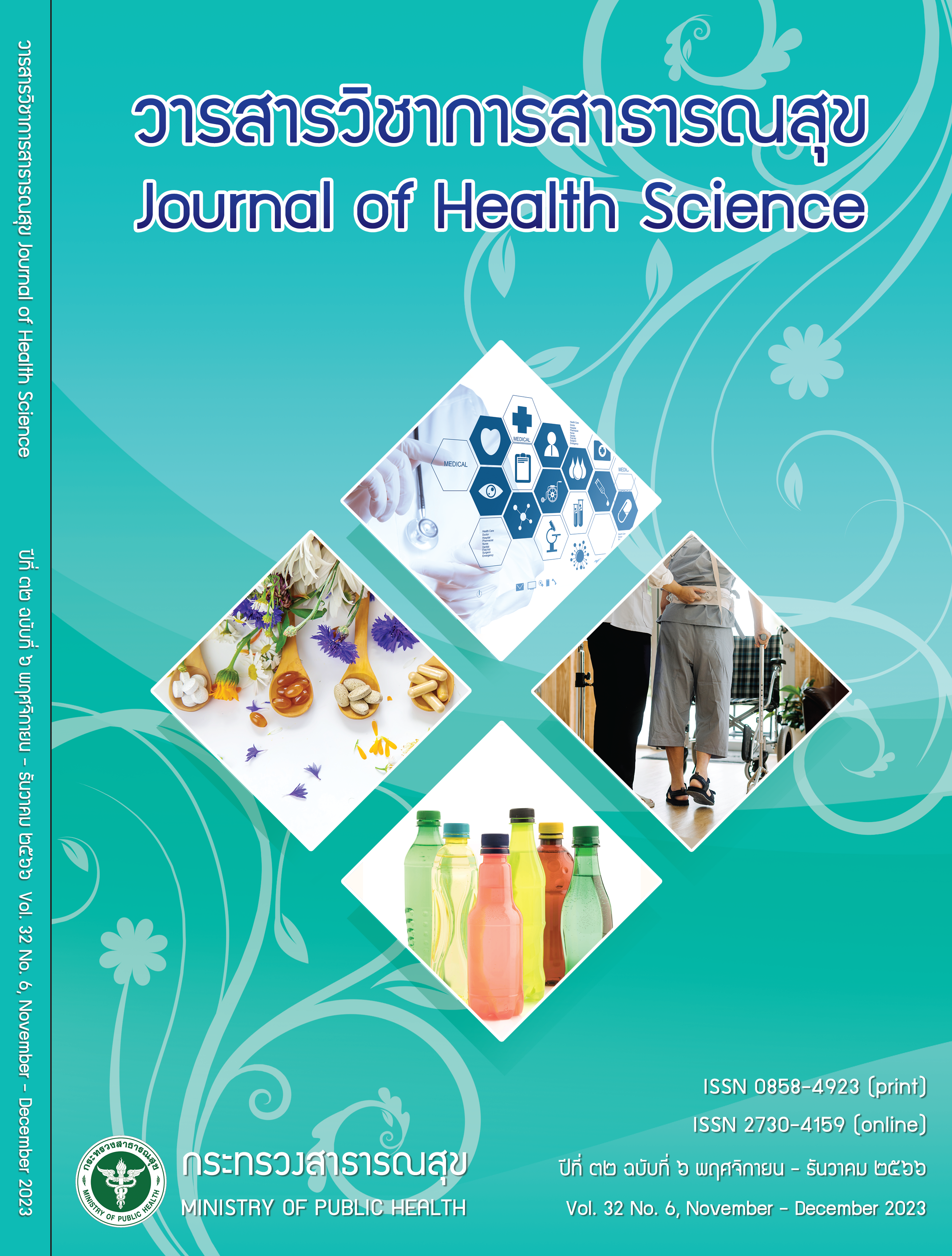Comparative Efficacy of Chlorination Methods in Drinking Water Production
Keywords:
water conditioning, chlorination, dosing pump, free residual chlorine, microbial contaminationAbstract
Chlorination is a crucial step in eliminating microbial contaminants for drinking water production. Currently, there is a lack of information on the effectiveness of various chlorination methods. This observational cross-sectional study aimed to compare the efficiency of two chlorination methods (i.e., utilizing a dosing pump and manual chlorination) in the raw water preparation process for drinking water production. Water samples and data were collected from 23 drinking water production sites in Tha Bo District, Nong Khai Province, Thailand. After chlorination using both methods, the water samples were analyzed using standard test kits for qualitative testing in terms of free residual chlorine levels according to the standard criteria of 0.2-0.5 ppm (pass/fail) and the presence of microbial contamination (detected/ not detected). The main outcomes were statistically compared between the groups using Fisher’s exact test. We observed that 17 out of 23 water production sites (73.9%) used dosing pumps for chlorination. Interestingly, the percentage of water samples with acceptable residual chlorine content was 94.1% and 16.7% in the sites using dosing pumps and those using manual chlorination, respectively (p<0.05). Similar statistically significant relationships were found between chlorination methods and the presence of microbial contamination (p<0.05). Furthermore, subgroup analysis of sites using underground water as a production resource had also shown consistent findings. In conclusion, this study indicates that the use of dosing pumps is more effective than manual chlorination in the drinking water production process. Therefore, we recommend the widespread adoption of dosing pumps to enhance the quality of drinking water and ensure consumer safety.
Downloads
References
กรมควบคุมโรค. ประกาศเตือนประชาชนป้ องกันโรคและ ภัยสุขภาพในช่วงฤดูร้อน [อินเทอร์เน็ต]. 2564 [สืบค้นเมื่อ 13 ส.ค. 2564]. แหล่งข้อมูล: https://ddc.moph.go.th/brc/news.php?news=17604&deptcode=
นิภาพรรณ สฤษดิ์ อภิรักษ์, ชำนาญ ไวแสน, กิตติพิชญ์ จันที, ไผท สิงห์คำ, กรรณิการ์ หมอนพังเทียม, บวรวรรณ ดิเรกโภค, และคณะ. การระบาดของโรคไว้รัสตับอักเสบเอ ในจังหวัดบึงกาฬ พ.ศ. 2555: การปนเปื้อนเชื้อจากน้ำแข็งสำหรับบริโภคของโรงงานแห่งหนึ่ง. วารสารวิชาการสาธารณสุข 2558;24(4):600-11.
สำนักงานคณะกรรมการอาหารและยา. แนวทางการป้องกันปัญหาการปนเปื้อนของจุลินทรีย์ในการผลิตน้ำบริโภคบรรจุขวด. พิมพ์ครั้งที่ 2. กรุงเทพมหานคร: องค์การสงเคราะห์ทหารผ่านศึก; 2547.
กองควบคุมอาหาร สำนักงานคณะกรรมการอาหารและยา. คู่มือการตรวจสถานที่ ผลิตตามหลักเกณฑ์ GMP น้ำบริโภค ในภาชนะบรรจุที่ปิดสนิท. ฉบับที่ 2. กรุงเทพมหานคร: องค์การสงเคราะห์ทหารผ่านศึก; 2551.
คู่มือสำหรับผู้ควบคุมการผลิต น้ำบริโภคในภาชนะบรรจุ ที่ปิดสนิท น้ำแร่ธรรมชาติและน้ำแข็งบริโภค. นนทบุรี: กองอาหาร สำนักคณะกรรมการอาหารและยา; 2564.
ศูนย์ห้องปฏิบัติการกรมอนามัย กรมอนามัย. User manual for drinking water test kit. นนทบุรี: กรมอนามัย; 2558.
คู่มือมาตรฐานน้ำดื่มประเทศไทย. สำนักคุณภาพและความปลอดภัยอาหาร. นนทบุรี: กรมวิทยาศาสตร์การแพทย์; 2562.
มัทนา สมบัติวัฒนาเวศ, ชิดชนก เรือนก้อน. สถานการณ์คุณภาพน้ำดื่มจากตู้น้ำหยอดเหรียญและระบบการบำรุงรักษาในพื้นที่อำเภอเชียงม่วน จังหวัดพะเยา. วารสารเภสัชกรรมไทย 2563;12(2):288-98.
Downloads
Published
How to Cite
Issue
Section
License

This work is licensed under a Creative Commons Attribution-NonCommercial-NoDerivatives 4.0 International License.







